MBA501 Dynamic Strategy: Facebook Stakeholder Analysis Report
VerifiedAdded on 2022/10/12
|13
|2217
|475
Report
AI Summary
This report provides a comprehensive stakeholder analysis of Facebook, examining its vision, mission, and recent developments. The report begins with an introduction to Facebook, outlining its objectives and challenges. It then identifies and categorizes key stakeholders, including clients/users, government officials, commercial companies, management, communities, company staff, and industry rivals, using a stakeholder view model. The core of the report focuses on in-depth analyses of four crucial stakeholder groups: commercial companies, clients/users, Facebook staff, and industry rivals. Each analysis assesses stakeholder behavior, competitive threats, cooperative potential, motives, and the impact on Facebook's business. The report concludes with a summary of the key findings, emphasizing the dynamic interplay among Facebook and its stakeholders, and the challenges of the social media landscape. The analysis incorporates insights from academic sources and industry reports to provide a well-rounded perspective on the company's strategic environment.
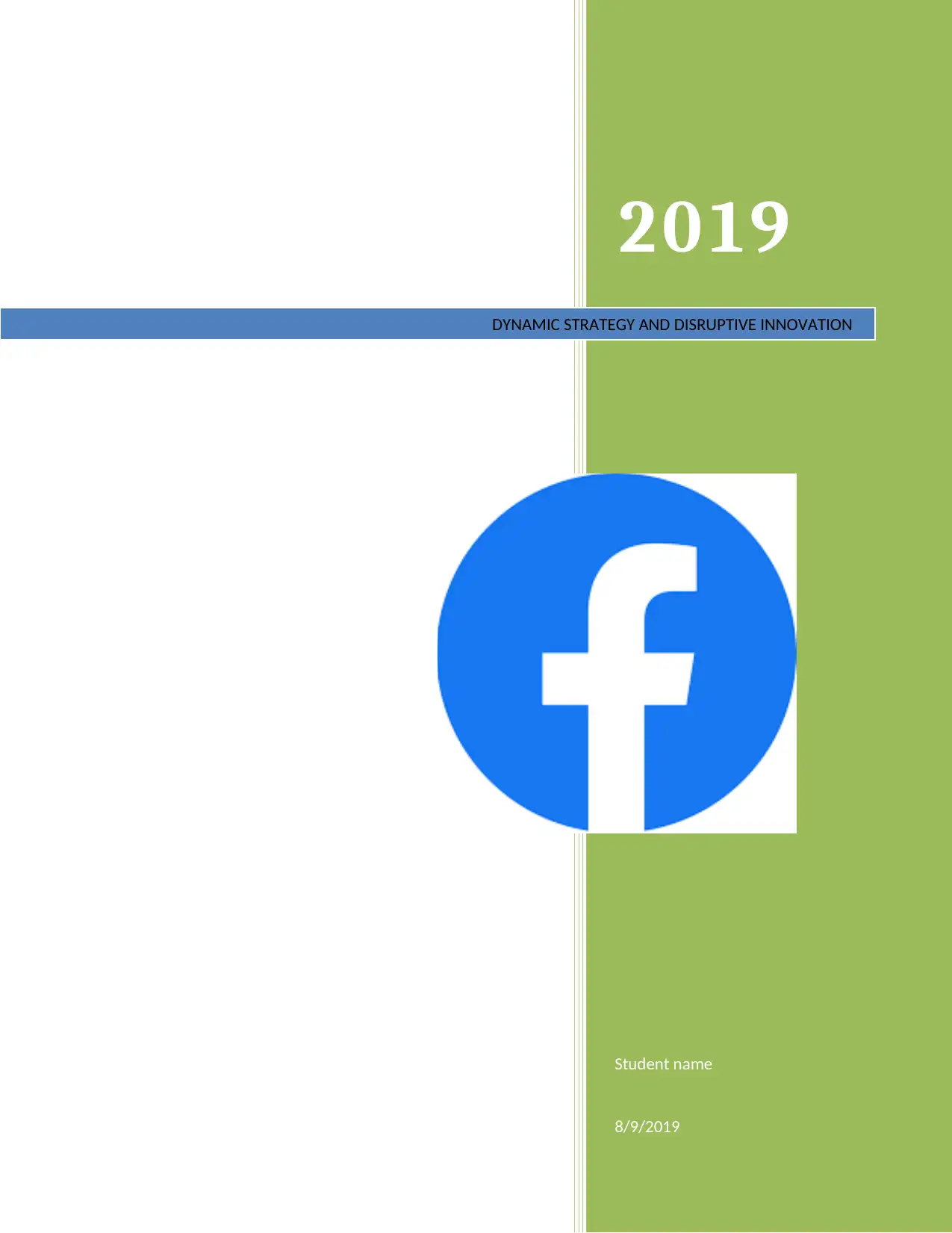
2019
Student name
8/9/2019
DYNAMIC STRATEGY AND DISRUPTIVE INNOVATION
Student name
8/9/2019
DYNAMIC STRATEGY AND DISRUPTIVE INNOVATION
Paraphrase This Document
Need a fresh take? Get an instant paraphrase of this document with our AI Paraphraser
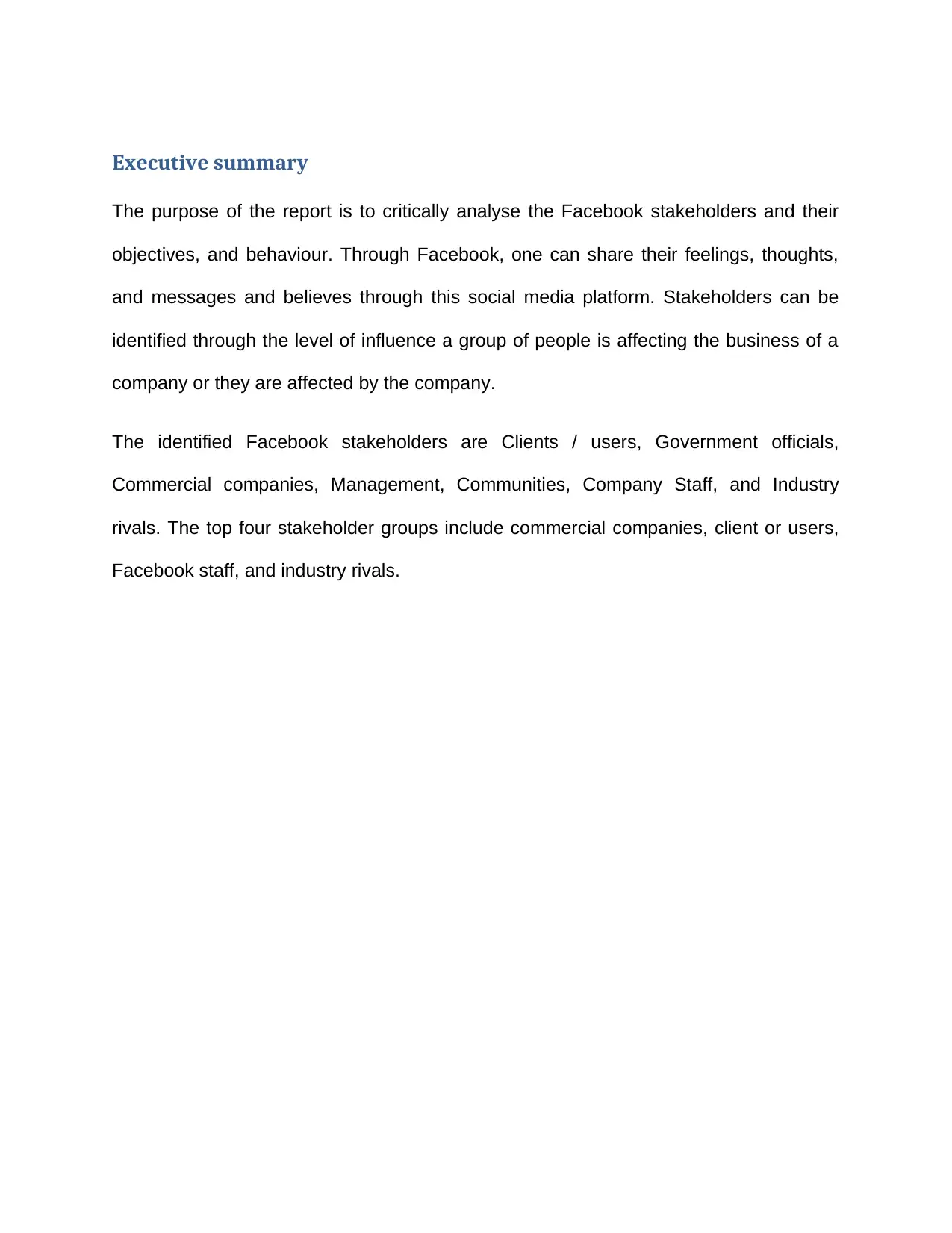
Executive summary
The purpose of the report is to critically analyse the Facebook stakeholders and their
objectives, and behaviour. Through Facebook, one can share their feelings, thoughts,
and messages and believes through this social media platform. Stakeholders can be
identified through the level of influence a group of people is affecting the business of a
company or they are affected by the company.
The identified Facebook stakeholders are Clients / users, Government officials,
Commercial companies, Management, Communities, Company Staff, and Industry
rivals. The top four stakeholder groups include commercial companies, client or users,
Facebook staff, and industry rivals.
The purpose of the report is to critically analyse the Facebook stakeholders and their
objectives, and behaviour. Through Facebook, one can share their feelings, thoughts,
and messages and believes through this social media platform. Stakeholders can be
identified through the level of influence a group of people is affecting the business of a
company or they are affected by the company.
The identified Facebook stakeholders are Clients / users, Government officials,
Commercial companies, Management, Communities, Company Staff, and Industry
rivals. The top four stakeholder groups include commercial companies, client or users,
Facebook staff, and industry rivals.
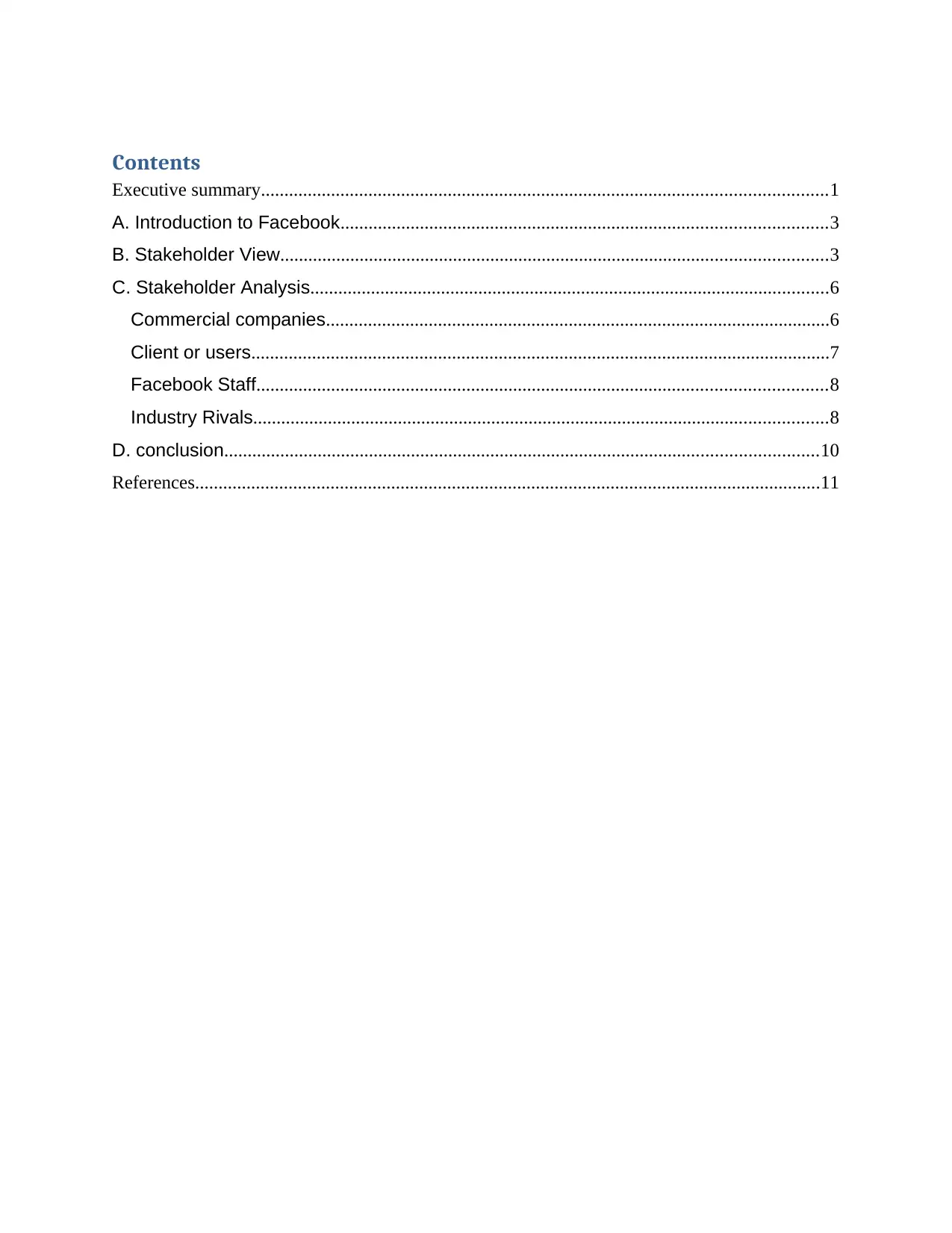
Contents
Executive summary.........................................................................................................................1
A. Introduction to Facebook........................................................................................................3
B. Stakeholder View.....................................................................................................................3
C. Stakeholder Analysis...............................................................................................................6
Commercial companies............................................................................................................6
Client or users............................................................................................................................7
Facebook Staff..........................................................................................................................8
Industry Rivals...........................................................................................................................8
D. conclusion...............................................................................................................................10
References......................................................................................................................................11
Executive summary.........................................................................................................................1
A. Introduction to Facebook........................................................................................................3
B. Stakeholder View.....................................................................................................................3
C. Stakeholder Analysis...............................................................................................................6
Commercial companies............................................................................................................6
Client or users............................................................................................................................7
Facebook Staff..........................................................................................................................8
Industry Rivals...........................................................................................................................8
D. conclusion...............................................................................................................................10
References......................................................................................................................................11
⊘ This is a preview!⊘
Do you want full access?
Subscribe today to unlock all pages.

Trusted by 1+ million students worldwide
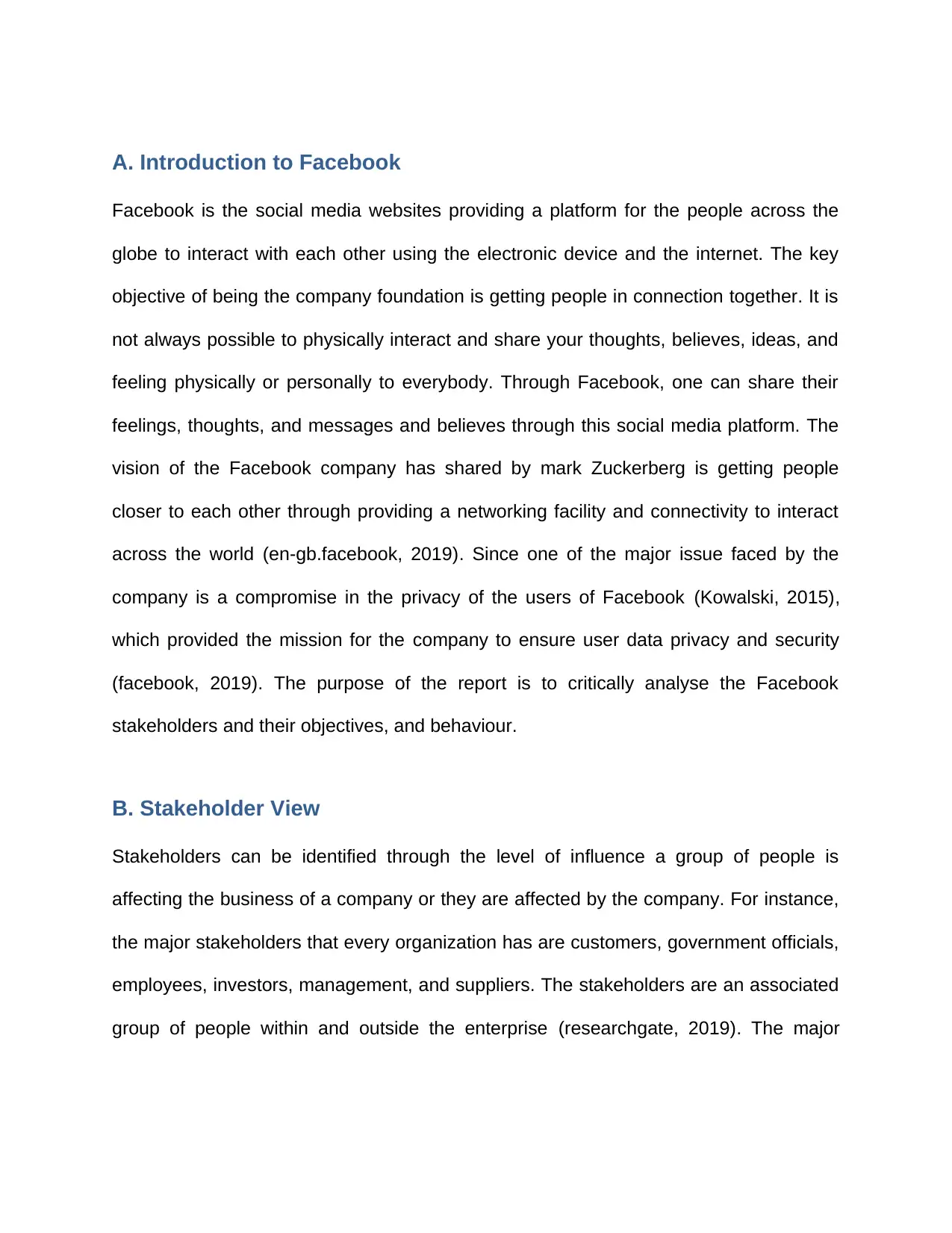
A. Introduction to Facebook
Facebook is the social media websites providing a platform for the people across the
globe to interact with each other using the electronic device and the internet. The key
objective of being the company foundation is getting people in connection together. It is
not always possible to physically interact and share your thoughts, believes, ideas, and
feeling physically or personally to everybody. Through Facebook, one can share their
feelings, thoughts, and messages and believes through this social media platform. The
vision of the Facebook company has shared by mark Zuckerberg is getting people
closer to each other through providing a networking facility and connectivity to interact
across the world (en-gb.facebook, 2019). Since one of the major issue faced by the
company is a compromise in the privacy of the users of Facebook (Kowalski, 2015),
which provided the mission for the company to ensure user data privacy and security
(facebook, 2019). The purpose of the report is to critically analyse the Facebook
stakeholders and their objectives, and behaviour.
B. Stakeholder View
Stakeholders can be identified through the level of influence a group of people is
affecting the business of a company or they are affected by the company. For instance,
the major stakeholders that every organization has are customers, government officials,
employees, investors, management, and suppliers. The stakeholders are an associated
group of people within and outside the enterprise (researchgate, 2019). The major
Facebook is the social media websites providing a platform for the people across the
globe to interact with each other using the electronic device and the internet. The key
objective of being the company foundation is getting people in connection together. It is
not always possible to physically interact and share your thoughts, believes, ideas, and
feeling physically or personally to everybody. Through Facebook, one can share their
feelings, thoughts, and messages and believes through this social media platform. The
vision of the Facebook company has shared by mark Zuckerberg is getting people
closer to each other through providing a networking facility and connectivity to interact
across the world (en-gb.facebook, 2019). Since one of the major issue faced by the
company is a compromise in the privacy of the users of Facebook (Kowalski, 2015),
which provided the mission for the company to ensure user data privacy and security
(facebook, 2019). The purpose of the report is to critically analyse the Facebook
stakeholders and their objectives, and behaviour.
B. Stakeholder View
Stakeholders can be identified through the level of influence a group of people is
affecting the business of a company or they are affected by the company. For instance,
the major stakeholders that every organization has are customers, government officials,
employees, investors, management, and suppliers. The stakeholders are an associated
group of people within and outside the enterprise (researchgate, 2019). The major
Paraphrase This Document
Need a fresh take? Get an instant paraphrase of this document with our AI Paraphraser
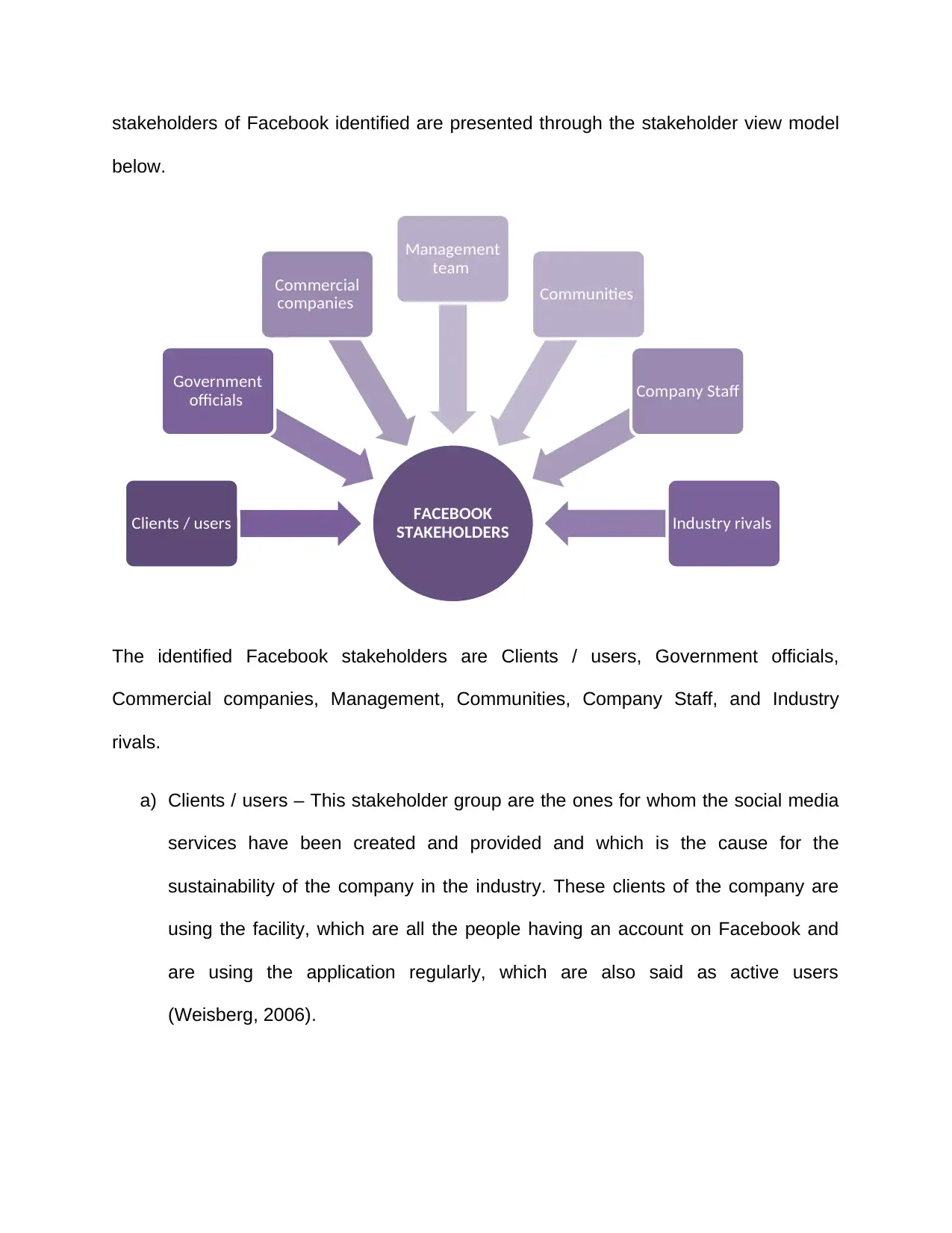
stakeholders of Facebook identified are presented through the stakeholder view model
below.
The identified Facebook stakeholders are Clients / users, Government officials,
Commercial companies, Management, Communities, Company Staff, and Industry
rivals.
a) Clients / users – This stakeholder group are the ones for whom the social media
services have been created and provided and which is the cause for the
sustainability of the company in the industry. These clients of the company are
using the facility, which are all the people having an account on Facebook and
are using the application regularly, which are also said as active users
(Weisberg, 2006).
FACEBOOK
STAKEHOLDERS
Clients / users
Government
officials
Commercial
companies
Management
team
Communities
Company Staff
Industry rivals
below.
The identified Facebook stakeholders are Clients / users, Government officials,
Commercial companies, Management, Communities, Company Staff, and Industry
rivals.
a) Clients / users – This stakeholder group are the ones for whom the social media
services have been created and provided and which is the cause for the
sustainability of the company in the industry. These clients of the company are
using the facility, which are all the people having an account on Facebook and
are using the application regularly, which are also said as active users
(Weisberg, 2006).
STAKEHOLDERS
Clients / users
Government
officials
Commercial
companies
Management
team
Communities
Company Staff
Industry rivals
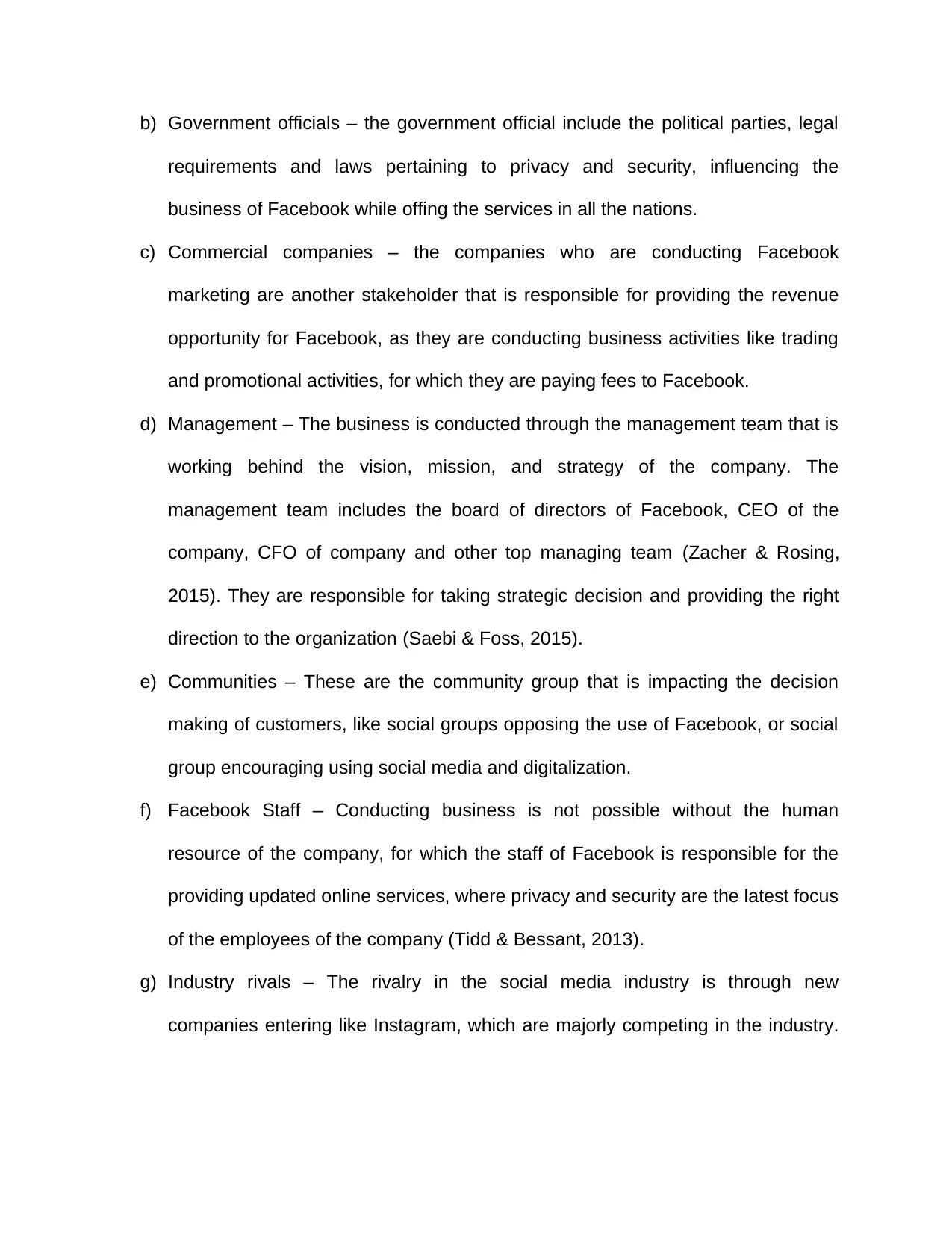
b) Government officials – the government official include the political parties, legal
requirements and laws pertaining to privacy and security, influencing the
business of Facebook while offing the services in all the nations.
c) Commercial companies – the companies who are conducting Facebook
marketing are another stakeholder that is responsible for providing the revenue
opportunity for Facebook, as they are conducting business activities like trading
and promotional activities, for which they are paying fees to Facebook.
d) Management – The business is conducted through the management team that is
working behind the vision, mission, and strategy of the company. The
management team includes the board of directors of Facebook, CEO of the
company, CFO of company and other top managing team (Zacher & Rosing,
2015). They are responsible for taking strategic decision and providing the right
direction to the organization (Saebi & Foss, 2015).
e) Communities – These are the community group that is impacting the decision
making of customers, like social groups opposing the use of Facebook, or social
group encouraging using social media and digitalization.
f) Facebook Staff – Conducting business is not possible without the human
resource of the company, for which the staff of Facebook is responsible for the
providing updated online services, where privacy and security are the latest focus
of the employees of the company (Tidd & Bessant, 2013).
g) Industry rivals – The rivalry in the social media industry is through new
companies entering like Instagram, which are majorly competing in the industry.
requirements and laws pertaining to privacy and security, influencing the
business of Facebook while offing the services in all the nations.
c) Commercial companies – the companies who are conducting Facebook
marketing are another stakeholder that is responsible for providing the revenue
opportunity for Facebook, as they are conducting business activities like trading
and promotional activities, for which they are paying fees to Facebook.
d) Management – The business is conducted through the management team that is
working behind the vision, mission, and strategy of the company. The
management team includes the board of directors of Facebook, CEO of the
company, CFO of company and other top managing team (Zacher & Rosing,
2015). They are responsible for taking strategic decision and providing the right
direction to the organization (Saebi & Foss, 2015).
e) Communities – These are the community group that is impacting the decision
making of customers, like social groups opposing the use of Facebook, or social
group encouraging using social media and digitalization.
f) Facebook Staff – Conducting business is not possible without the human
resource of the company, for which the staff of Facebook is responsible for the
providing updated online services, where privacy and security are the latest focus
of the employees of the company (Tidd & Bessant, 2013).
g) Industry rivals – The rivalry in the social media industry is through new
companies entering like Instagram, which are majorly competing in the industry.
⊘ This is a preview!⊘
Do you want full access?
Subscribe today to unlock all pages.

Trusted by 1+ million students worldwide
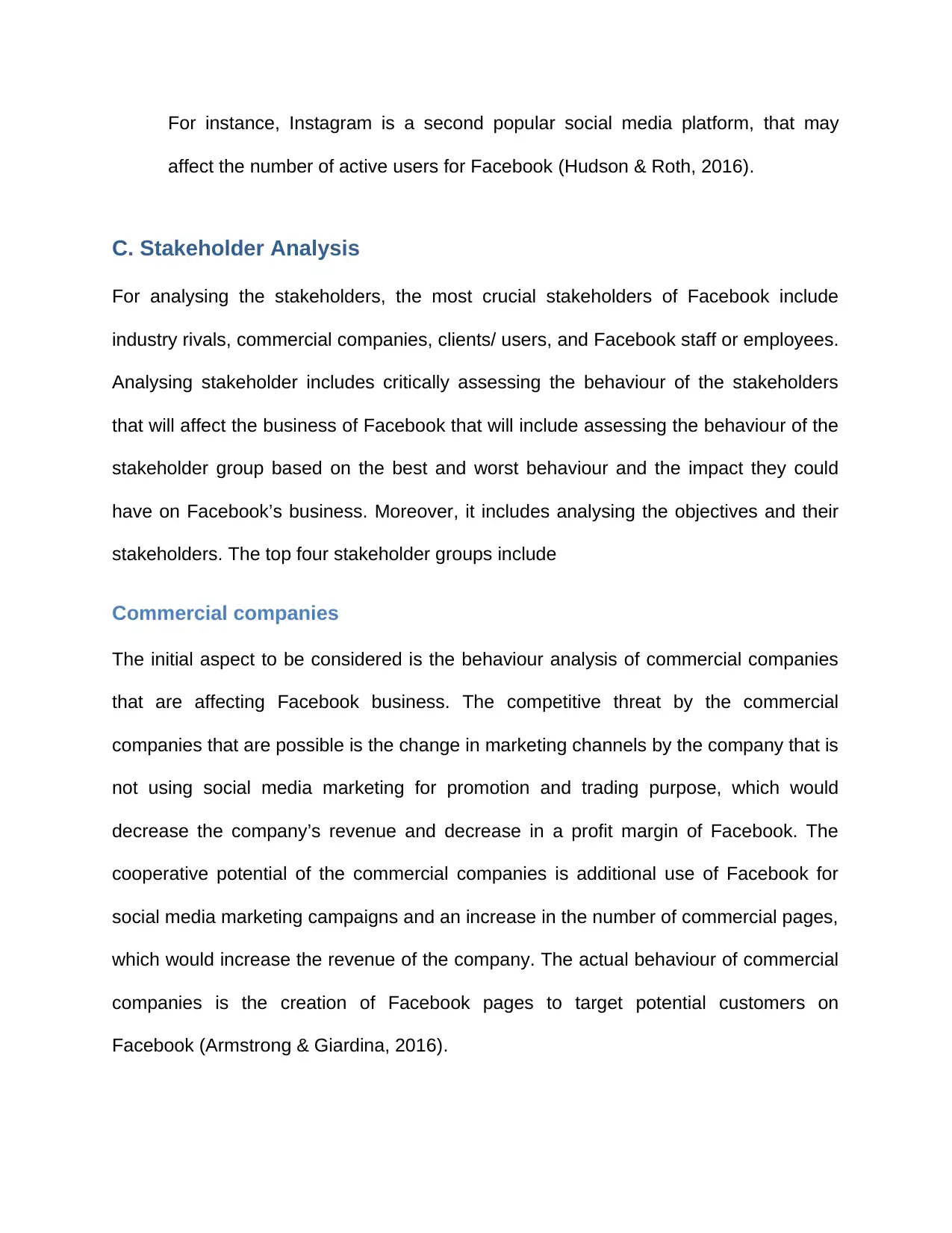
For instance, Instagram is a second popular social media platform, that may
affect the number of active users for Facebook (Hudson & Roth, 2016).
C. Stakeholder Analysis
For analysing the stakeholders, the most crucial stakeholders of Facebook include
industry rivals, commercial companies, clients/ users, and Facebook staff or employees.
Analysing stakeholder includes critically assessing the behaviour of the stakeholders
that will affect the business of Facebook that will include assessing the behaviour of the
stakeholder group based on the best and worst behaviour and the impact they could
have on Facebook’s business. Moreover, it includes analysing the objectives and their
stakeholders. The top four stakeholder groups include
Commercial companies
The initial aspect to be considered is the behaviour analysis of commercial companies
that are affecting Facebook business. The competitive threat by the commercial
companies that are possible is the change in marketing channels by the company that is
not using social media marketing for promotion and trading purpose, which would
decrease the company’s revenue and decrease in a profit margin of Facebook. The
cooperative potential of the commercial companies is additional use of Facebook for
social media marketing campaigns and an increase in the number of commercial pages,
which would increase the revenue of the company. The actual behaviour of commercial
companies is the creation of Facebook pages to target potential customers on
Facebook (Armstrong & Giardina, 2016).
affect the number of active users for Facebook (Hudson & Roth, 2016).
C. Stakeholder Analysis
For analysing the stakeholders, the most crucial stakeholders of Facebook include
industry rivals, commercial companies, clients/ users, and Facebook staff or employees.
Analysing stakeholder includes critically assessing the behaviour of the stakeholders
that will affect the business of Facebook that will include assessing the behaviour of the
stakeholder group based on the best and worst behaviour and the impact they could
have on Facebook’s business. Moreover, it includes analysing the objectives and their
stakeholders. The top four stakeholder groups include
Commercial companies
The initial aspect to be considered is the behaviour analysis of commercial companies
that are affecting Facebook business. The competitive threat by the commercial
companies that are possible is the change in marketing channels by the company that is
not using social media marketing for promotion and trading purpose, which would
decrease the company’s revenue and decrease in a profit margin of Facebook. The
cooperative potential of the commercial companies is additional use of Facebook for
social media marketing campaigns and an increase in the number of commercial pages,
which would increase the revenue of the company. The actual behaviour of commercial
companies is the creation of Facebook pages to target potential customers on
Facebook (Armstrong & Giardina, 2016).
Paraphrase This Document
Need a fresh take? Get an instant paraphrase of this document with our AI Paraphraser
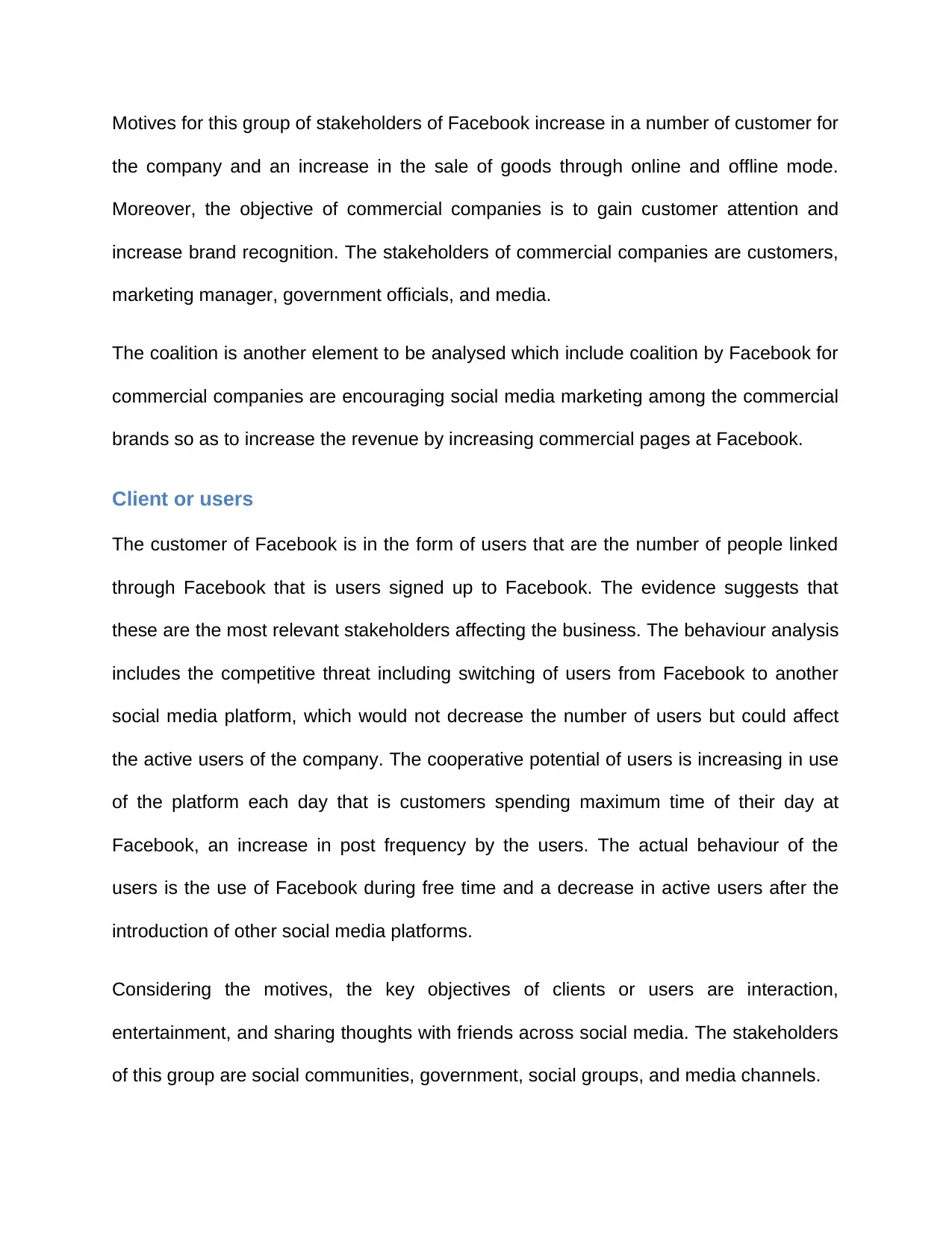
Motives for this group of stakeholders of Facebook increase in a number of customer for
the company and an increase in the sale of goods through online and offline mode.
Moreover, the objective of commercial companies is to gain customer attention and
increase brand recognition. The stakeholders of commercial companies are customers,
marketing manager, government officials, and media.
The coalition is another element to be analysed which include coalition by Facebook for
commercial companies are encouraging social media marketing among the commercial
brands so as to increase the revenue by increasing commercial pages at Facebook.
Client or users
The customer of Facebook is in the form of users that are the number of people linked
through Facebook that is users signed up to Facebook. The evidence suggests that
these are the most relevant stakeholders affecting the business. The behaviour analysis
includes the competitive threat including switching of users from Facebook to another
social media platform, which would not decrease the number of users but could affect
the active users of the company. The cooperative potential of users is increasing in use
of the platform each day that is customers spending maximum time of their day at
Facebook, an increase in post frequency by the users. The actual behaviour of the
users is the use of Facebook during free time and a decrease in active users after the
introduction of other social media platforms.
Considering the motives, the key objectives of clients or users are interaction,
entertainment, and sharing thoughts with friends across social media. The stakeholders
of this group are social communities, government, social groups, and media channels.
the company and an increase in the sale of goods through online and offline mode.
Moreover, the objective of commercial companies is to gain customer attention and
increase brand recognition. The stakeholders of commercial companies are customers,
marketing manager, government officials, and media.
The coalition is another element to be analysed which include coalition by Facebook for
commercial companies are encouraging social media marketing among the commercial
brands so as to increase the revenue by increasing commercial pages at Facebook.
Client or users
The customer of Facebook is in the form of users that are the number of people linked
through Facebook that is users signed up to Facebook. The evidence suggests that
these are the most relevant stakeholders affecting the business. The behaviour analysis
includes the competitive threat including switching of users from Facebook to another
social media platform, which would not decrease the number of users but could affect
the active users of the company. The cooperative potential of users is increasing in use
of the platform each day that is customers spending maximum time of their day at
Facebook, an increase in post frequency by the users. The actual behaviour of the
users is the use of Facebook during free time and a decrease in active users after the
introduction of other social media platforms.
Considering the motives, the key objectives of clients or users are interaction,
entertainment, and sharing thoughts with friends across social media. The stakeholders
of this group are social communities, government, social groups, and media channels.
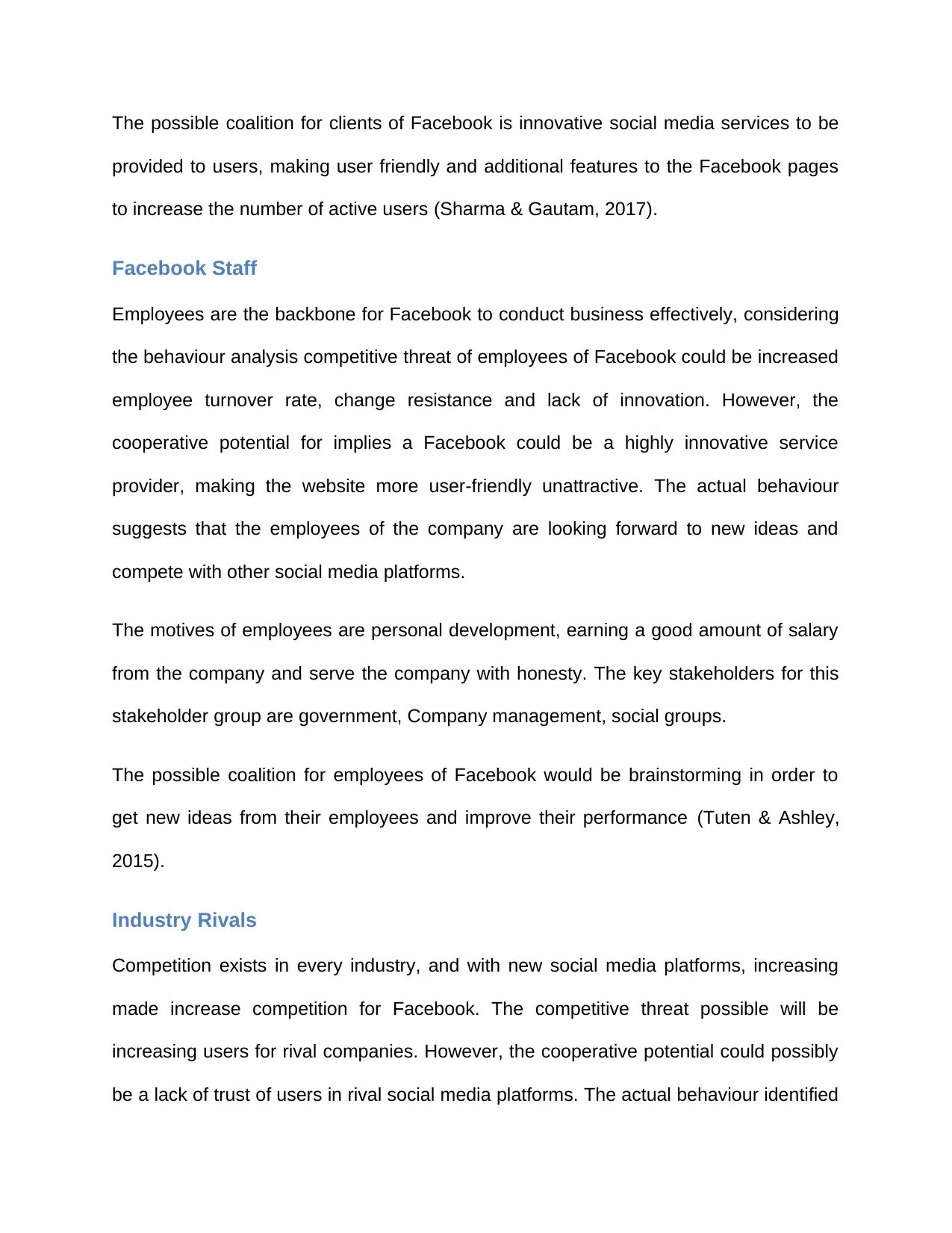
The possible coalition for clients of Facebook is innovative social media services to be
provided to users, making user friendly and additional features to the Facebook pages
to increase the number of active users (Sharma & Gautam, 2017).
Facebook Staff
Employees are the backbone for Facebook to conduct business effectively, considering
the behaviour analysis competitive threat of employees of Facebook could be increased
employee turnover rate, change resistance and lack of innovation. However, the
cooperative potential for implies a Facebook could be a highly innovative service
provider, making the website more user-friendly unattractive. The actual behaviour
suggests that the employees of the company are looking forward to new ideas and
compete with other social media platforms.
The motives of employees are personal development, earning a good amount of salary
from the company and serve the company with honesty. The key stakeholders for this
stakeholder group are government, Company management, social groups.
The possible coalition for employees of Facebook would be brainstorming in order to
get new ideas from their employees and improve their performance (Tuten & Ashley,
2015).
Industry Rivals
Competition exists in every industry, and with new social media platforms, increasing
made increase competition for Facebook. The competitive threat possible will be
increasing users for rival companies. However, the cooperative potential could possibly
be a lack of trust of users in rival social media platforms. The actual behaviour identified
provided to users, making user friendly and additional features to the Facebook pages
to increase the number of active users (Sharma & Gautam, 2017).
Facebook Staff
Employees are the backbone for Facebook to conduct business effectively, considering
the behaviour analysis competitive threat of employees of Facebook could be increased
employee turnover rate, change resistance and lack of innovation. However, the
cooperative potential for implies a Facebook could be a highly innovative service
provider, making the website more user-friendly unattractive. The actual behaviour
suggests that the employees of the company are looking forward to new ideas and
compete with other social media platforms.
The motives of employees are personal development, earning a good amount of salary
from the company and serve the company with honesty. The key stakeholders for this
stakeholder group are government, Company management, social groups.
The possible coalition for employees of Facebook would be brainstorming in order to
get new ideas from their employees and improve their performance (Tuten & Ashley,
2015).
Industry Rivals
Competition exists in every industry, and with new social media platforms, increasing
made increase competition for Facebook. The competitive threat possible will be
increasing users for rival companies. However, the cooperative potential could possibly
be a lack of trust of users in rival social media platforms. The actual behaviour identified
⊘ This is a preview!⊘
Do you want full access?
Subscribe today to unlock all pages.

Trusted by 1+ million students worldwide
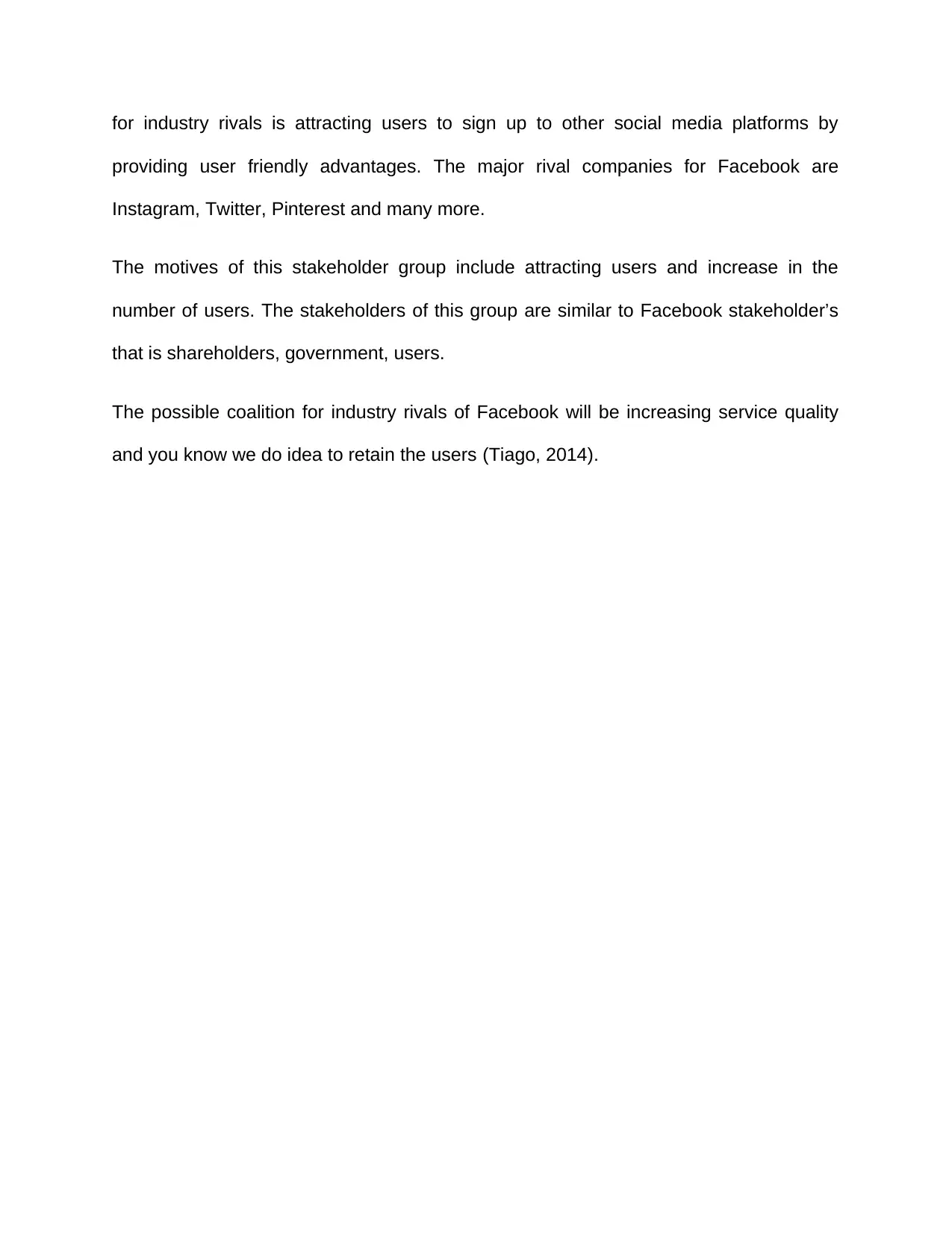
for industry rivals is attracting users to sign up to other social media platforms by
providing user friendly advantages. The major rival companies for Facebook are
Instagram, Twitter, Pinterest and many more.
The motives of this stakeholder group include attracting users and increase in the
number of users. The stakeholders of this group are similar to Facebook stakeholder’s
that is shareholders, government, users.
The possible coalition for industry rivals of Facebook will be increasing service quality
and you know we do idea to retain the users (Tiago, 2014).
providing user friendly advantages. The major rival companies for Facebook are
Instagram, Twitter, Pinterest and many more.
The motives of this stakeholder group include attracting users and increase in the
number of users. The stakeholders of this group are similar to Facebook stakeholder’s
that is shareholders, government, users.
The possible coalition for industry rivals of Facebook will be increasing service quality
and you know we do idea to retain the users (Tiago, 2014).
Paraphrase This Document
Need a fresh take? Get an instant paraphrase of this document with our AI Paraphraser
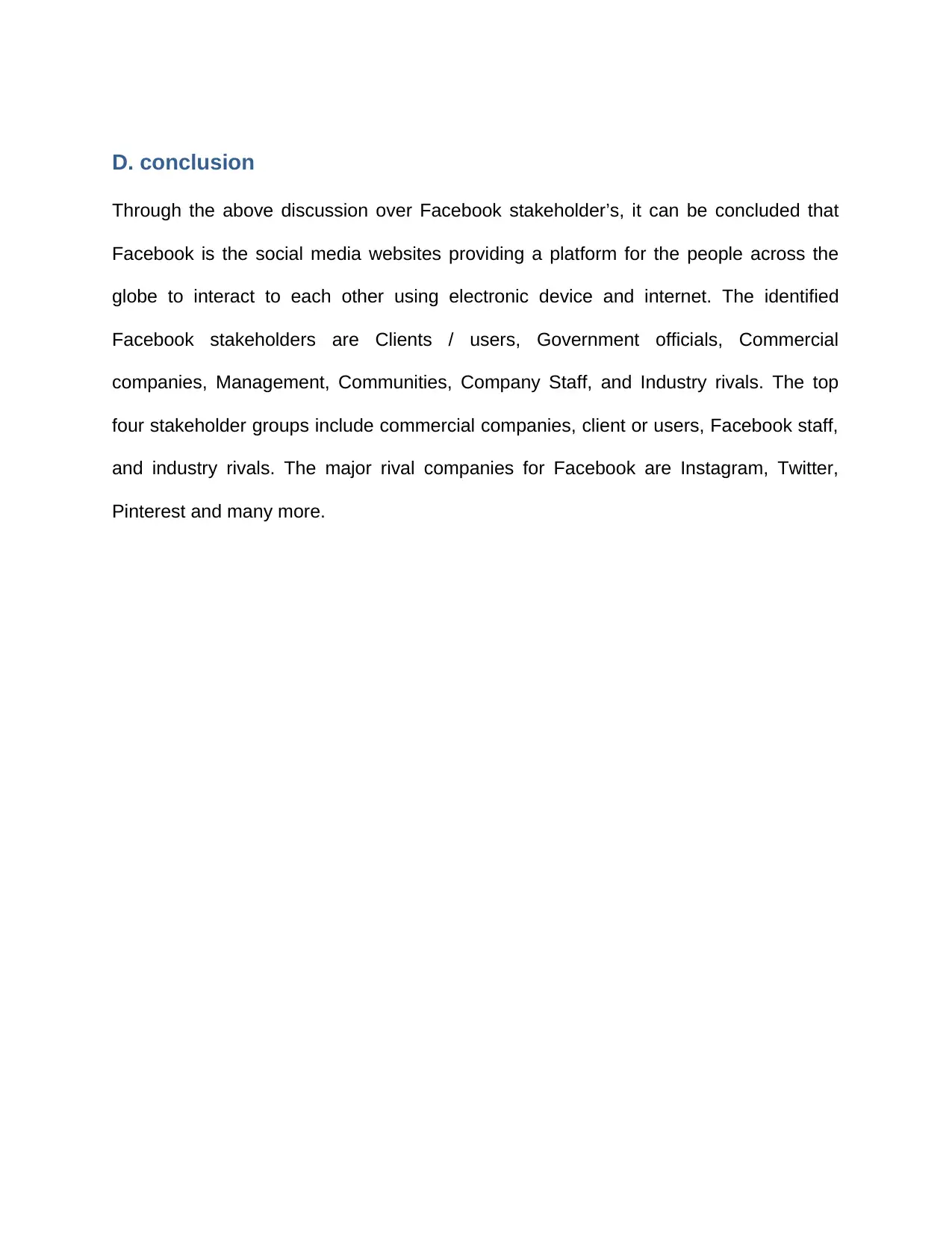
D. conclusion
Through the above discussion over Facebook stakeholder’s, it can be concluded that
Facebook is the social media websites providing a platform for the people across the
globe to interact to each other using electronic device and internet. The identified
Facebook stakeholders are Clients / users, Government officials, Commercial
companies, Management, Communities, Company Staff, and Industry rivals. The top
four stakeholder groups include commercial companies, client or users, Facebook staff,
and industry rivals. The major rival companies for Facebook are Instagram, Twitter,
Pinterest and many more.
Through the above discussion over Facebook stakeholder’s, it can be concluded that
Facebook is the social media websites providing a platform for the people across the
globe to interact to each other using electronic device and internet. The identified
Facebook stakeholders are Clients / users, Government officials, Commercial
companies, Management, Communities, Company Staff, and Industry rivals. The top
four stakeholder groups include commercial companies, client or users, Facebook staff,
and industry rivals. The major rival companies for Facebook are Instagram, Twitter,
Pinterest and many more.
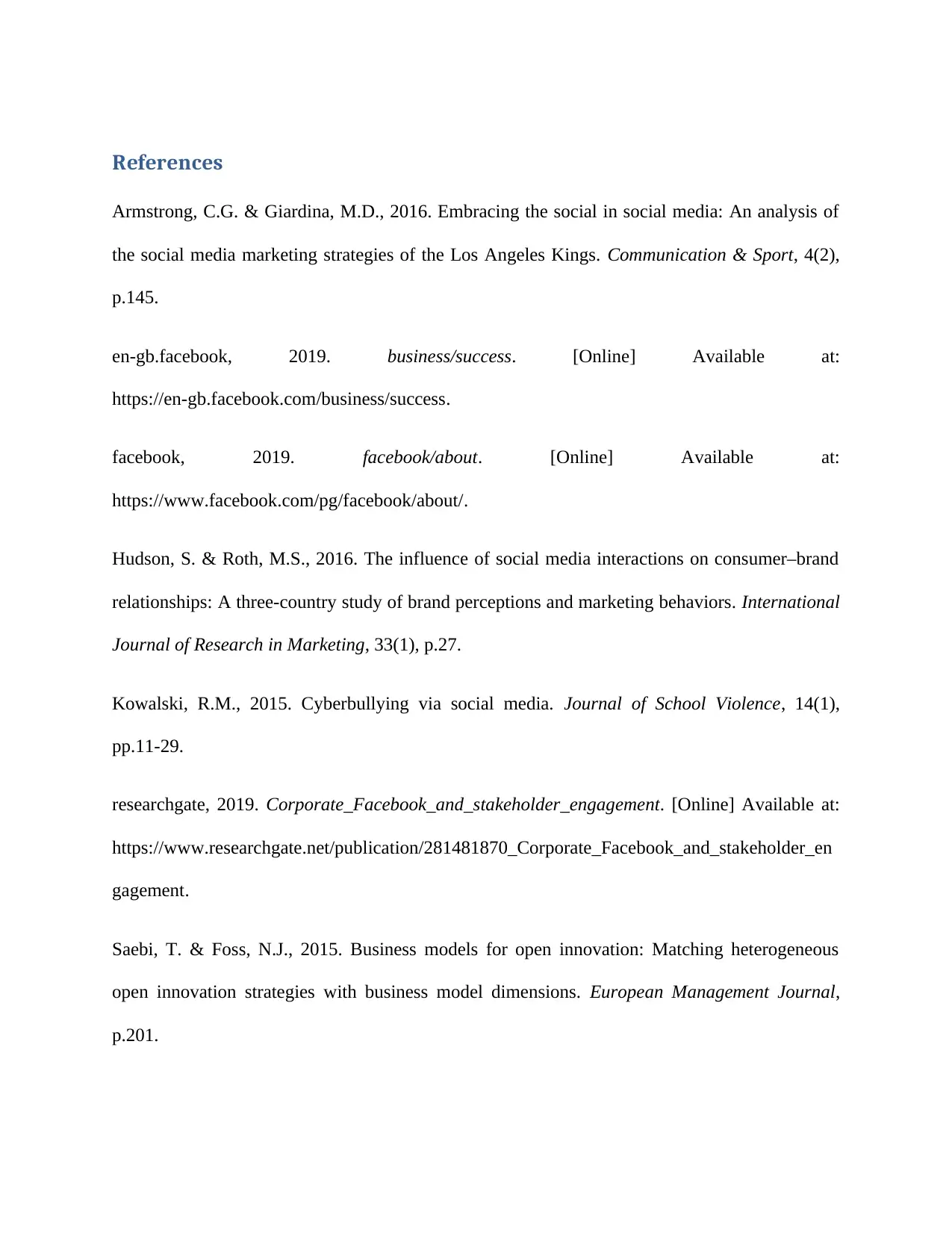
References
Armstrong, C.G. & Giardina, M.D., 2016. Embracing the social in social media: An analysis of
the social media marketing strategies of the Los Angeles Kings. Communication & Sport, 4(2),
p.145.
en-gb.facebook, 2019. business/success. [Online] Available at:
https://en-gb.facebook.com/business/success.
facebook, 2019. facebook/about. [Online] Available at:
https://www.facebook.com/pg/facebook/about/.
Hudson, S. & Roth, M.S., 2016. The influence of social media interactions on consumer–brand
relationships: A three-country study of brand perceptions and marketing behaviors. International
Journal of Research in Marketing, 33(1), p.27.
Kowalski, R.M., 2015. Cyberbullying via social media. Journal of School Violence, 14(1),
pp.11-29.
researchgate, 2019. Corporate_Facebook_and_stakeholder_engagement. [Online] Available at:
https://www.researchgate.net/publication/281481870_Corporate_Facebook_and_stakeholder_en
gagement.
Saebi, T. & Foss, N.J., 2015. Business models for open innovation: Matching heterogeneous
open innovation strategies with business model dimensions. European Management Journal,
p.201.
Armstrong, C.G. & Giardina, M.D., 2016. Embracing the social in social media: An analysis of
the social media marketing strategies of the Los Angeles Kings. Communication & Sport, 4(2),
p.145.
en-gb.facebook, 2019. business/success. [Online] Available at:
https://en-gb.facebook.com/business/success.
facebook, 2019. facebook/about. [Online] Available at:
https://www.facebook.com/pg/facebook/about/.
Hudson, S. & Roth, M.S., 2016. The influence of social media interactions on consumer–brand
relationships: A three-country study of brand perceptions and marketing behaviors. International
Journal of Research in Marketing, 33(1), p.27.
Kowalski, R.M., 2015. Cyberbullying via social media. Journal of School Violence, 14(1),
pp.11-29.
researchgate, 2019. Corporate_Facebook_and_stakeholder_engagement. [Online] Available at:
https://www.researchgate.net/publication/281481870_Corporate_Facebook_and_stakeholder_en
gagement.
Saebi, T. & Foss, N.J., 2015. Business models for open innovation: Matching heterogeneous
open innovation strategies with business model dimensions. European Management Journal,
p.201.
⊘ This is a preview!⊘
Do you want full access?
Subscribe today to unlock all pages.

Trusted by 1+ million students worldwide
1 out of 13
Related Documents
Your All-in-One AI-Powered Toolkit for Academic Success.
+13062052269
info@desklib.com
Available 24*7 on WhatsApp / Email
![[object Object]](/_next/static/media/star-bottom.7253800d.svg)
Unlock your academic potential
Copyright © 2020–2025 A2Z Services. All Rights Reserved. Developed and managed by ZUCOL.





